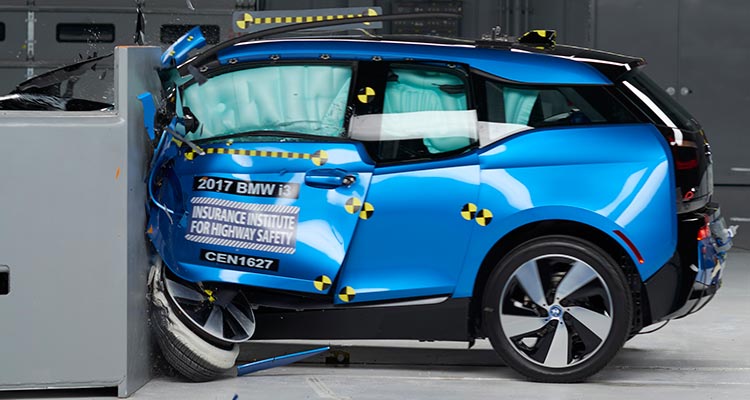Tesla’s 2017 Model S and BMW’s 2017 i3 electric vehicles failed to qualify for the Insurance Institute for Highway Safety’s Top Safety Pick award. IIHS said that the Model S received good ratings in all evaluation areas except the small-overlap front crash test, which the group said is a “challenging” test for which the Tesla only earned an acceptable rating.
The two models did not fail any of the crash tests, but did fall short of meeting all the criteria needed to be rated a “Top Safety Pick” by the IIHS.
The small-overlap test — added in 2012 — replicates what happens when a vehicle runs off the road and hits a tree or pole or clips another vehicle that has crossed the center line.
In the small-overlap test, the IIHS says the Model S safety belt allowed the dummy’s torso to move too far forward so the dummy’s head hit the steering wheel through the airbag. The IIHS also raised concerns about potential leg injuries for drivers involved in small overlap front crashes.
“Neither of these (potential injuries) were so high that we would expect life threatening injuries, but they are too high in our opinion to get “Good” ratings for those body regions,” said Dave Zuby with IIHS.
In the test, 25 percent of the total width of the vehicle hits a 5-foot-tall rigid barrier on the driver side at 40 miles per hour.
The 2017 BMW i3, meanwhile, earned good ratings in all of the group’s criteria except the tests for head restraint and seat evaluation, which the group said measures a vehicle’s ability to protect against neck injuries in a rear crash. The IIHS rated the i3 acceptable in the head restraint test.
The IIHS notes Tesla has made production changes to the Model S to improve its ability to protect passengers and that the updated model will be tested at some point by IIHS.
The IIHS notes that Tesla and BMW have attempted to improve safety of the cars. Tesla has made production changes to the Model S to improve its ability to protect passengers and that the updated model will be tested at some point by IIHS.
For BMW, the i3 received its “acceptable” rating in head restraint and seat evaluation, which measure how the vehicle will do protecting against neck injuries in a rear crash.
“We expect that the BMW engineers are working on improving the rear crash protection of the seats and look forward to testing those when they’re available,” said Zuby.
Zuby added: “BMW clearly thought a lot about safety when designing the i3. It’s a shame that it missed the mark on head restraints, which is something most of today’s vehicles get right. Among small cars, the i3 is the only 2017 model that doesn’t get a good rating.”
We’ve reached out to BMW for a comment.
Update
BMW of North America Communications Manager Alex Schmuck said the following: “We narrowly missed the IIHS rear impact test rating of “Good” and therefore the BMW i3 does not achieve a IIHS Top Safety + rating. However, the BMW i3 with its carbon-fiber structure is designed to meet and exceed global safety standards.”







































































